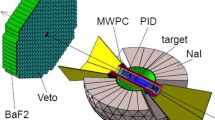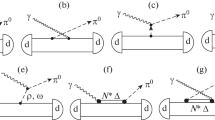Abstract
The excited-state spectrum of the nucleon is a complicated overlap of many resonances that must be disentangled through multipole analyses of reaction amplitudes. Meson photoproduction, which has been a fruitful probe of N\(^*\) structure, requires data on many different polarization observables to constrain its four complex amplitudes. While considerable data has been accumulated with proton targets, comparatively little information is available from neutron targets. Recently, the first beam-target helicity asymmetries with circular beam polarization in the \(\gamma n(p)\rightarrow \pi ^-p(p)\) reaction have been reported (Hao et al. in PRL 118:242002, 2017). This paper presents a parallel analysis from the same experiment of polarization observables with linearly polarized beams for the same reaction. Linearly polarized photons and longitudinally polarized deuterons in a solid hydrogen deuteride target were used with the CEBAF Large Acceptance Spectrometer at Jefferson lab (JLab). Data are combined to extract the beam (\(\varSigma \)) and beam-target double-polarization (G) asymmetries. Preliminary results for the \(\varSigma \) observables are consistent with existing partial wave analyses (PWA) that incorporate other experiments. Preliminary results for the energy and angular dependence of G are reported; these deviate strongly from existing PWA.
Similar content being viewed by others
References
D. Hao et al., Beam-target helicity asymmetry for \(\varvec {\gamma }{\bf n}\rightarrow \pi ^-p\) in the N\(^*\) resonance region. PRL 118, 242002 (2017)
R. Bijker et al., Strong decays of baryons and missing resonances. PRD 94, 074040 (2016)
N. Isgur, G. Karl, \(P\)-wave baryons in the quark model. PRD 18, 4187 (1978)
N. Isgur, G. Karl, \(P\)-wave baryons in the quark model. PRD D19, 2653 (1979)
N. Isgur, G. Karl, \(P\)-wave baryons in the quark model. PRD D20, 1191 (1979)
M. Giannini et al., The hypercentral constituent quark model and its application to baryon properties. Chin. J. Phys. 53, 020301 (2015)
R.L. Jaffe, Exotica. Phys. Rept. 409, 1 (2005)
E. Santopinto, Interacting Quark–Diquark Model of Baryons. Phys. Rev. C 72, 022201 (2005)
J. Ferretti et al., Relativisitc quark–diquark model of baryons. Phys. Rev. C 83, 065204 (2011)
M. De Sanctis et al., Electromagnetic form factors in the relativistic interacting quark–diquark model of baryons. Phys. Rev. C 84, 055201 (2011)
M. De Sanctis et al., Electromagnetic form factors in the relativistic interacting quark–diquark model of baryons. Eur. Phys. J. A 52, 121 (2016)
E. Santopinto, J. Ferretti, Strange and nonstrange baryon spectra in the relativistic interacting quark–diquark model with a Gürsey and radicati-inspired exchange interaction. Phys. Rev. C 92, 025202 (2015)
G. Galata, E. Santopinto, Hybrid quark–diquark baryon model. Phys. Rev. C 86, 045202 (2012)
N. Suzuki et al., Disentangling the dynamical origin of \(P_{11}\) nucleon resonances. PRL 104, 042302 (2010)
A.M. Sandorfi et al., Determining pseudoscalar meson photoproduction amplitudes from complete experiments. J. Phys. G 38, 053001 (2011)
B.A. Mecking et al., The CEBAF large acceptance spectrometer (CLAS). Nucl. Instrum. Meth. A 503, 513 (2003)
C.D. Bass et al., A portable cryostat for the cold transfer of polarized solid HD targets: HD-Ice-I. Nucl. Instrum. Meth. A 737, 107 (2014)
M.M. Lowry et al., A cryostat to hold frozen-spin polarized HD targets in CLAS: HDice-II. Nucl. Instrum. Meth. A 815, 31 (2016)
X. Wei et al., Boosting Deuteron Polarization in HD Targets: Experience of moving spins between H and D with RF methods during the E06-101 experiment at Jefferson Lab, PoS, PSTP2013, 016 (2014)
Acknowledgements
This work was supported by the U.S. Department of Energy, Office of Nuclear Physics Division, under Contract No. DE-AC05-06OR23177, under which Jefferson Science Associates operate Jefferson Laboratory, by the US National Science Foundation, and by the funding agencies of CLAS collaboration members.
Author information
Authors and Affiliations
Consortia
Corresponding author
Additional information
Publisher's Note
Springer Nature remains neutral with regard to jurisdictional claims in published maps and institutional affiliations.
This article belongs to the Topical Collection “NSTAR 2017 - The International Workshop on the Physics of Excited Nucleons”.
Rights and permissions
About this article
Cite this article
Lu, H.Y., for the g14 Analysis Group and the CLAS Collaboration. \({\varvec{\gamma n(p)\rightarrow \pi ^-p(p)}}\) Asymmetries with Linearly Polarized Beams and Longitudinally Polarized Targets in the N\(^*\) Resonance Region. Few-Body Syst 60, 18 (2019). https://doi.org/10.1007/s00601-019-1486-z
Received:
Accepted:
Published:
DOI: https://doi.org/10.1007/s00601-019-1486-z




